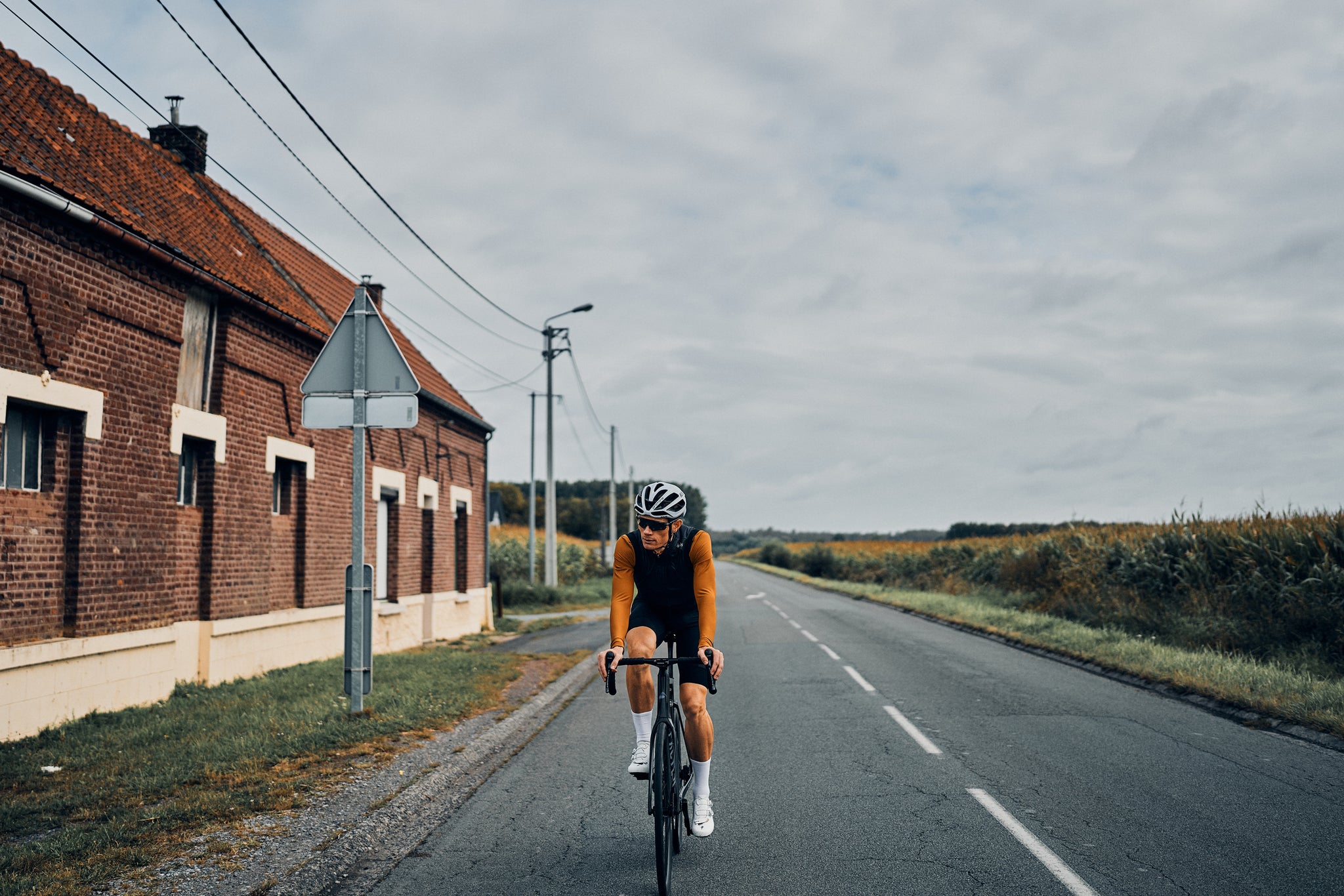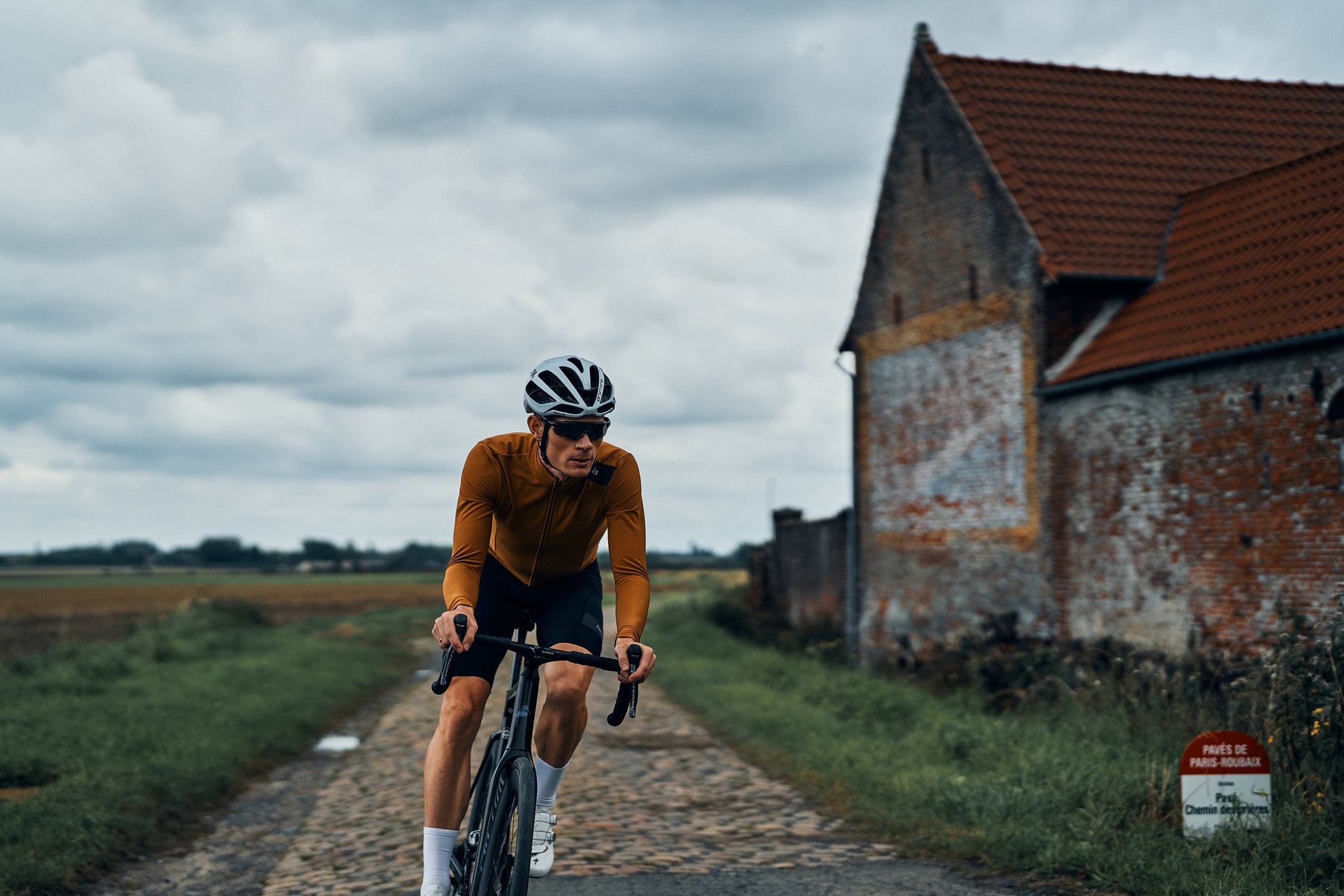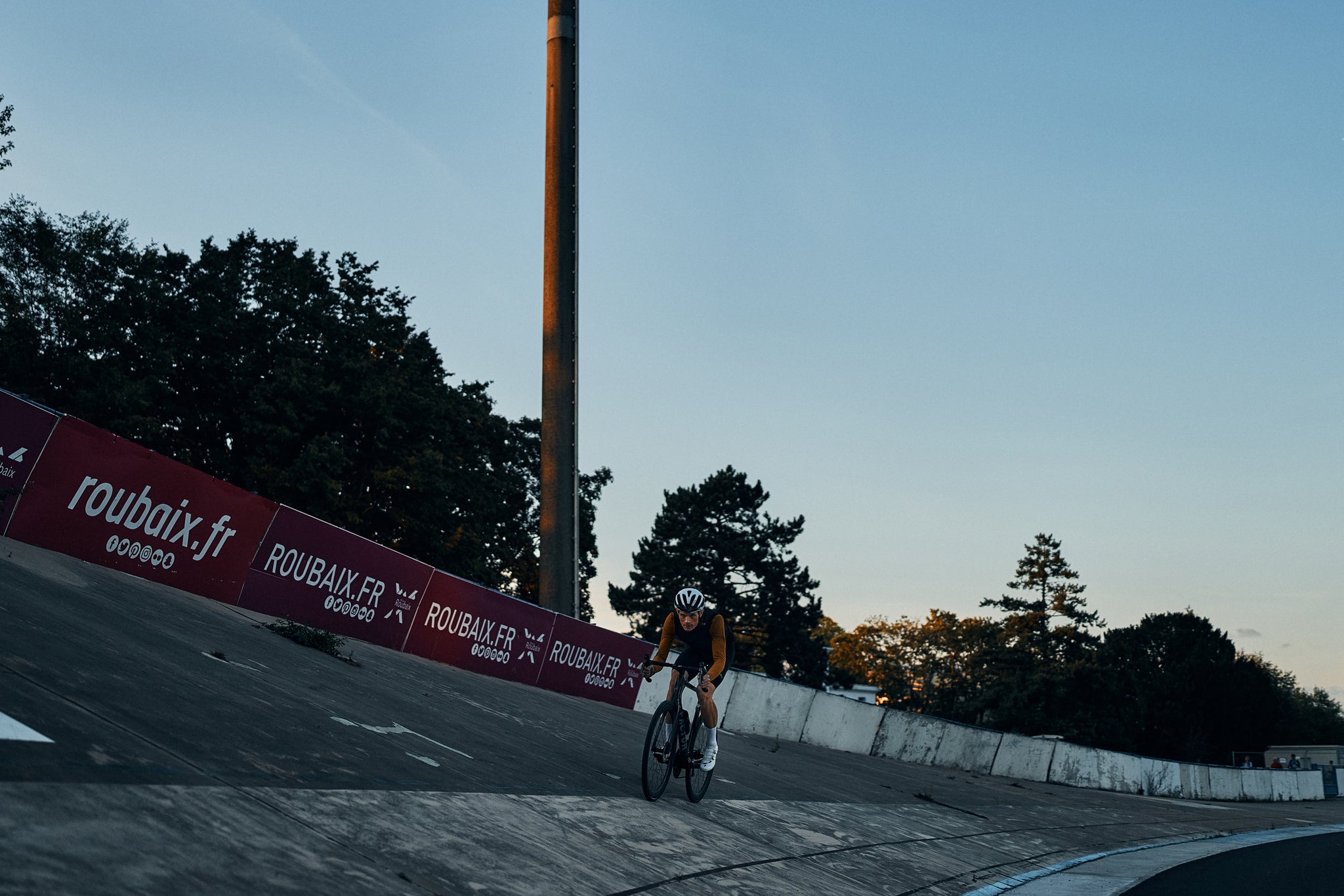This is my Paris-Roubaix / This is my isoles
It's early Sunday morning in Valenciennes in the French department of Nord - close to the Belgian border. The hotel hums with activity, the classic architecture unchanged for decades. It is as if we are in a scene from an old French movie. A rider sits at the breakfast table getting ready, just as he might have done 125 years ago.
Freshly baked baguettes and croissants fill the bread basket, alongside it, local French cheese and homemade blueberry jam. Freshly squeezed orange juice and a strong espresso, brewed in the French style, help to complete his meal. A long day lies ahead, on the historic roads between Valenciennes and Roubaix.
The rider is Rasmus Fjordside - and he has ridden the Paris-Roubaix race before, as U23 rider back in 2005. This time he returns to these roads as an isolés, with no expectations and no pressure on his shoulders. This time Rasmus has the opportunity to experience this part of the world outside of a race, 125 years after the first edition of one of the most famous bike races in cycling.

Valenciennes is still asleep and the roads are completely empty as Rasmus rides out of town. Clouds are in the sky and the air feels cool. The forecast is for rain.
The road out of town leads through classic French streets. Green shutters on the windows, small balconies and pavements choked with parked cars, some a little too close to each other.
As Rasmus leaves the city, the vista opens up as the road cuts through an agricultural heartland.
At that moment, Rasmus is greeted by the most beautiful sunrise, the sky alive with warmth. A beautiful morning and a just reward for getting up before most this Sunday.
The feeling of freedom is so much stronger when one is alone in these landscapes. No drivers, only the silence - it almost defines the story Rasmus is going to experience.

Valenciennes is considered by many to be the deciding point of the race. This is where the longest and hardest pavé pieces start. Up to this point, they have been manageable.
Rasmus is heading directly towards the Trouée d'Arenberg - better known as the Arenberg Forest. One of the most legendary locations in cycling. There is a relatively long stretch of good asphalt before the road meets the Arenberg, and like the rest of the route it is completely flat. It is not the height differences that soften the rider’s resolve, it is the surface and the stress of the race.
But Rasmus does not stress today, he has time to soak up the mood and atmosphere. There is a feeling of happiness that only cycling can produce.
The quiet roads give Rasmus opportunity for contemplation.

Race day is a different matter. Chaos is guaranteed and the drama ratchets up when the field meets the Arenberg.
The Pavé which makes up the Arenberg Trench was laid back in the 18th century under Napoleon the 1st. They are brutally uneven and crooked - it is not without reason that every rider fears this stretch.
Beneath the forest is one of the area's largest disused coal mines, where several former professional cyclists also made a living, including Frenchman Jean Stablinski. He had a glorious career behind him, winning more than 105 professional victories, including stage victories in the Tour de France, French championships and a single World Championship. But at that time it did not lead to a life of fame and fortune in the principalities after the career. Cycling was still a working man’s sport and could not provide an income for the future. Jean worked in the dark coal mines under the forest to earn a living and pay for his past life as a racer. A tough life for one of the finest riders of his era.
When they were setting the course, the organisation behind the race consulted with Jean. They were looking for a tougher and more selective contest. It was Jean who recommended running the route through the Arenberg Trench. A road he did every single day going for the mines. In 1977, the sector was introduced and it was immediately clear that it worked as intended.

Paris-Roubaix is not won in the Arenberg forest - but it can definitely be lost here.
This morning, however, it is peaceful inside Arenberg - only a single morning dog walker and a couple of runners have found their way onto the 2km long road through the forest.
As soon as Rasmus hits the bricks, EVERYTHING vibrates. The bike, the chain and his body. He almost dances over the cobbles, the clatter from his bike, the chain and the pedals performing a complex melody.
He simultaneously experiences a rush of euphoria. This is what he has come for. That feeling. Him and the cobblestones, just as he experienced it back in 2005. But this time it's different. He does not have the same fear in his back pocket, he feels free. This time around, he can enjoy the trip and the story. It’s a strong moment.

On the other side of Arenberg, 5km of asphalt awaits. The body is given a brief respite from the punishment, it has some time to recover. But now the pavé sections are coming like pearls on a string towards Roubaix.
One by one, they sap the energy and drain the power from the legs.
Ahead awaits another equally well-known pavé section. Pont Gibus - named after Gilbert Duclos Lassalle. He made his decisive attacks on this very category four sector, giving him two victories in Roubaix.

The pavé is divided by a railway crossing, and several times the field has been caught behind the train and breakaways have been given an extra advantage - a god's hand for the adventurous.
Today, however, the train is neither a teammate nor an opponent and Rasmus calmly rolls through the old bridge that marks the beginning of the sector and along the pavé.
Just next week, spectators will line this road, desperate to get close to the riders and experience the race on the closest terms.

On the other side of the Pont Gibus, asphalt and pavé alternate again and the body is suddenly struck by fatigue, as the beating from the cobbles begins to take its toll. It almost feels as if they are still there, bouncing the bike and pounding the flesh - even though the road is smooth.
The sun is fighting its way through the clouds and so far we have had no rain. That would have changed everything about this trip.

There is something unremarkable about the roads and cities around Roubaix. There doesn’t seem to be much of a hipster influence here, nothing flashy or excessive. The buildings stand with a purpose, solid, well maintained. Classically French / Belgian. This sense of purpose also characterizes the race.
The roads around here are used on a daily basis, mainly by local farmers and several of the pavé sections are private, only open to the owners of the land on which they lie. These roads are used to transport cattle and agricultural machinery - so the ground is hard, and the cobbles often worn.
A short stop in Helemes. In a small local shop, Rasmus finds some waffles and asks if the owner can fill his bottle with water. She does so with a smile, nodding appreciatively when she is told about his ride on the legendary cobbles.
The city is typical of this area around Roubaix, featuring only a small school and then houses and lots of farmland, even in the middle of the town.
A poster on a street corner tells us when the circus will be coming, and they’re not talking about the bicycle circus. This is the traditional version, with clowns. This is how it is. Solid, traditional and a bit old-fashioned.

It is less than 25 km directly to Roubaix, but the pavé meanders through the fields, making the route longer than necessary. This means we still have 50km left of the route. And the worst is yet to come.
Rasmus has enough time today, and can ride the sections at his leisure. That said, cobblestones need to be attacked. If not, they bite back.


The weather is still very grey. To the south, heavy clouds have formed, threatening rain. To the north towards Roubaix, it looks calmer. However, the sky seems dramatic in every direction - and that's how it should be. It actually suits the trip.
The cobblestones can look quite peaceful in dry weather, but with the slightest rain, they become as slippery as soap.
The first rain is always the worst, before the mud from the machines and muck from the cows has been washed away. It adds a level of excitement.

Luckily the weather gods are friendly today - and a light headwind against Roubaix is also a guarantee of dry weather for the rest of the day. Rasmus is approaching Roubaix and probably the last difficult sector of the race - the Carrefour de l'Arbre.
Starting in a small town, farms and villa gardens line the route all the way up to the pavé, which runs for 2km, beginning near the motorway and emerging beside the legendary restaurant.

Most often it is said that the rider who comes first out of Carrefour de l'Arbre wins on the line in Roubaix. Only 15 km remain from here to the potential fulfilment of your dreams at the velodrome in Roubaix. A kind of sacred cathedral for cycling.
The stones are abnormally poorly placed, angular and crooked. It feels difficult to rank these cobbles, because for riders who have never been here they will seem completely unmanageable - but speed is the key word.
In 2005, Rasmus was running well in the U23 edition of Paris-Roubaix - and sat in the field until they hit Carrefour de l'Arbre. Then, he punctured, and his dreams of glory at Roubaix deflated with his tyre. The ensuing chaos with wheel changes costs him crucial time and he finished a few minutes after the winner. Today, however, Rasmus elegantly exits the pavé - and ahead awaits the mythical velodrome.

500 meters of raw concrete - built in 1936 and one of the most important locations in cycling. Since 1942, the course has formed the framework around the climax of the Paris-Roubaix.
It has welcomed tired and battered riders after they have endured unbearable hardships in the north of France. The track has created winners, redeemed dreams, shattered hopes and not least created drama for a crowd of cycling-hungry TV viewers worldwide.


The velodrome is steeped in history - and for Rasmus it evokes fond memories of that spring day in April 2005.
He feels both sad about the puncture so close to the finish, but also a sense of pride that he has been here before. He has ridden this race, been where only a few have dared to ride, and where many have fallen.

As he rolls the same 1.5 laps as he did as an aspiring young cyclist, he looks back on an emotional journey through a piece of cycling history. Memories have been awakened, both from his own race and also from all the races he and the rest of the world have witnessed on the TV.
This place has a unique ambience, the spirit of cycling is in the air, you can almost touch it. So much cycling history has been written on this track, legends made.

With an eerily empty grandstand as his backdrop and without a hint of the professional cycling carnival that will fill this very stadium within a matter of days, Rasmus rolls over the finish line.
For many, it can be difficult to relate to the professional achievements we see on TV, but it is immediately easier to relate to oneself, one's own needs and dreams about cycling.
And while sitting here at the finish line, Rasmus enjoys the momentum, his Paris-Roubaix. A Paris-Roubaix run his way, with the opportunity to soak up history and with time to refresh old memories.
His cycling is now more than data, watts and chasing the top step on the podium. It is now deeper than that, more spiritual. He can feel it here, in this cathedral of cycle racing.
Precisely these moments make cycling unique.
